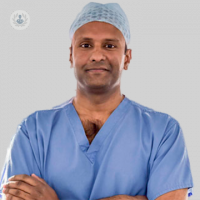How is a vasectomy reversed?
Autore:Vasovasostomy is a surgical procedure that reverses a vasectomy. Having a vasectomy is usually done as a form of contraception for men who want to prevent pregnancy occurring. It is a microsurgical procedure and takes a lot of skill. Mr Nikesh Thiruchelvam, a top urologist who runs a dedicated vasectomy reversal clinic, explains how vasectomy reversal is achieved.

Are vasectomies easily reversed?
I wouldn’t use the word easy! The vasa that are cut during a vasectomy are only 2mm in diameter and the lumen that carries the sperm is only around 0.8 mm on the prostatic side and 1.3mm on the testicular side. The testicular side dilates up after a vasectomy due to back pressure from seminal fluid that is trying to get through from the testis.
What is important is to have a skilled reconstructive urologist who has various reconstructive techniques up his sleeve to deal with all of the different situations that may arise and be encountered when performing a vasectomy reversal. The evidence would also suggest that performing a vasectomy reversal using an operating microscope yields better results than using the naked eye or using operating loupes (which are like magnifying glasses placed over each eye).
What does the vasectomy reversal procedure involve?
I perform this surgery with the patient asleep, under a general anaesthetic. The procedure takes between 1.5 to 2 hours. The general steps of the procedure are as follows:
- The testis is brought out of the scrotum via an incision and the damaged ends of the vas are cut back to where the tissue has a good blood supply.
- The vasal ends are sometimes cannulated or probed with an incredibly fine probe to ensure that the lumen or channel is patent.
- The vasal ends are then sutured together using incredibly fine sutures or stitches (around one-quarter of the thickness of a human hair) which are permanent or non-absorbable. Using these type of stitches, which are incredibly fine, I can reconnect the small vasal tubes.
- Using typical reconstructive techniques I ensure that these new joins heal without tension and with a good blood supply. Unlike some surgeons, both sides are operated on with two separate scrotal incisions.
How successful is a vasectomy reversal?
Despite the lower pregnancy rates, these rates are still a considerable improvement compared to published results with IVF. Most UK centres quote rates in the region of 30-35% pregnancy rates with IVF. Furthermore, unlike IVF, if you have a successful outcome with myself, you only pay the once to have more than one child should you wish for a larger family.
It can take up to a year for sperm to appear in the semen, but commonly, this will occur within a few months. There is a natural reduction in patency of the lumen over the years after a successful operation, of around 2-3% closure rate per year.
It is important to know that a successful outcome in producing sperm in the semen does not always lead to a successful pregnancy. Success rates are largely based on surgical expertise and time since vasectomy, in addition to general medical health issues, such as smoking or obesity.
If your vasectomy was less than 3 years ago, you have a 97% chance of getting sperm in the ejaculate (with 76% chance of a successful pregnancy). This drops to 70% success if the vasectomy was greater than 15 years ago.
How long is the recovery period?
When you wake from surgery, you will have a scrotal support jock strap on. This will be covering the two separate scrotal incisions. As the incisions are quite small, there usually isn’t much pain that it is not well controlled by painkillers you can take orally. The majority of men have pain that is similar to, or less than when you underwent the initial vasectomy. The stitches are dissolvable and will fall away after a few weeks.
Some dos and don’ts:
- You cannot drive yourself home after surgery as you will have had a general anaesthetic.
- You should have someone stay with you overnight.
- You can have a shower on the day after surgery.
- You should avoid sitting in a hot bath for some months, as this can adversely alter sperm function.
- After surgery, you may get some bruising and swelling in the scrotum but this usually resolves in the first week following your operation. As the stitches used to reconnect your cut vas tubes are very fine, it is important to undertake light duties only and not to undertake any rigorous physical activity for 2-3 weeks.
- You should also refrain from having any ejaculations or sexual activity until six weeks after surgery.
It is important that you plan the date of surgery such that commencing light duties ties in with your work plans. Rest and healing are of utmost importance.
After about six weeks of healing, you can start trying to conceive for a child. It can take an average of one year for your partner to become pregnant, although it is not unusual for this to occur within a few months.
If you have had a vasectomy but are considering having it reversed, make an appointment with an expert to discuss your options.


